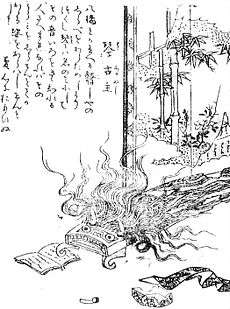Koto-furunushi

The Koto-furunushi (琴古主; English: "old master Koto") is a fictitious being from Japanese folklore. It belongs to the group of Yōkai and is said to be harmless to humans. The Koto-furunushi is very similar to the being Biwa-bokuboku.
Description
The Koto-furunushi has the appearance of a traditional Koto (a Japanese zither), which grows a demonic face on its front. The strings start to meander into all directions, giving the impression of an uncombed mane. However, it is not handed down, if the Koto-furunushi can move on its own in any kind.[1][2]
Folklore
A famous legend comes from Saga prefecture on Kyūshū peninsula and is said to originate from the 2nd century AD. It tells the story of the Emperor of Japan, who had planned an palatial feast for his royal court. He chose Kanzaki as the festive place and he ordered his gardeners to clean and groom the chosen park. The legend reports that the emperor was so excited about the resulting beauty of the festive place, that he left an enchanted Koto as a present to the town of Kanzaki. A short time later, the Koto magically transformed itself into an lush and noble camphor tree. From this day, it was told for centuries, that anybody, who took a rest at the roots of the tree, could hear the faint, but irresistibly calming sounds of a harp or zither from the treetop. Today it is told that the exact whereabout of the holy tree was forgotten in time, but the ghost of the camphor tree may dive into very old Kotos to animate them.[1][3]
Background
The Koto-furunushi belongs to a special group of yōkai: the Tsukumogami (jap. 付喪神; lit. "artifact ghosts"). This special group is believed to possess nearly all kinds of man-made household artifacts, such as kitchenware, tools and everyday accessories, and though 100 years may passed, the artifact appears as good as if it was never in use.[4] Koto-furunushi are said to come to life when "reaching their 100th birthday", but only if they were always treated with great respect. If so, they will always play the most enchanting music on their own, especially, when no one watches them. Most time, the Koto-furunushi will perform songs, which were played on them very often and with special devotion. If a Koto-furunushi is instead ignored by its owner, it will become sad and then ask other Tsukumogami to take it along with them. It then will play for its Tsukumogami friends, forgetting its neglectful owner in time.[1][2]
References
- 1 2 3 Hiroko Yoda, Matt Alt: Yokai Attack!: The Japanese Monster Survival Guide. Tuttle Publishing, Rutland 2013, ISBN 1462908837, p. 64.
- 1 2 Hisashi Yamauchi: もののけ. Hōsei daigaku shuppan-kyoku, Tokio 2004, ISBN 4588212222, p. 304.
- ↑ Shigeru Mizuki: 水木しげるの妖怪百物語: 日本篇. Futami Shobō, Tokyo 1999, ISBN 978-4-576-99102-3, p. 84-86.
- ↑ Michaela Haustein: Mythologien der Welt: Japan, Ainu, Korea. ePubli, Berlin 2011, ISBN 3844214070, p. 25.
